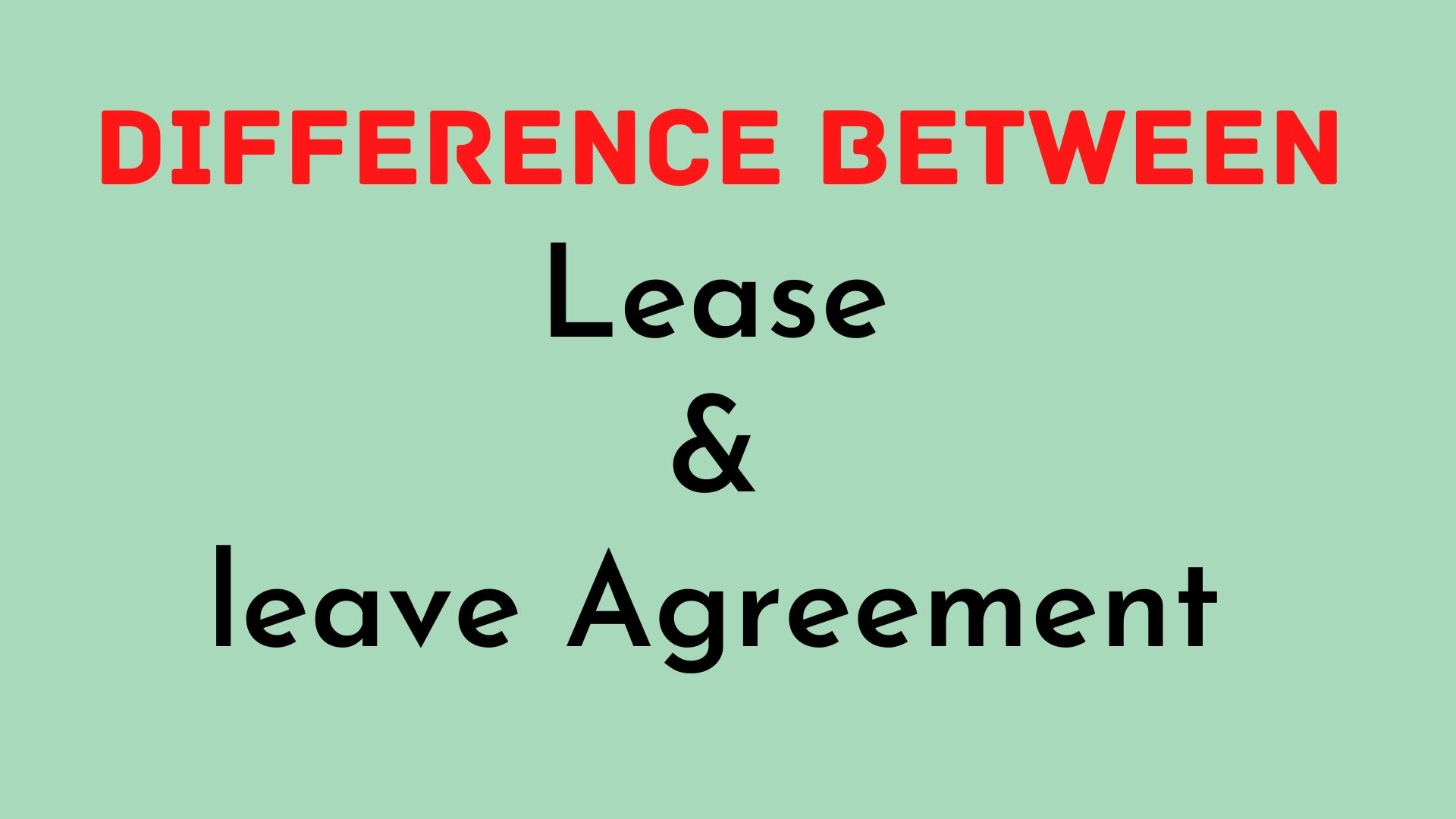What is the
difference between a lease agreement and a leave and license agreement?
A leave
and license agreement refers to the transfer of a limited right to perform
certain actions by a licensor. Such rights are personal and non-transferable. A
lease agreement, on the other hand, transfers enjoyment of immovable property
for a specific period of time. Both agreements are governed by the same laws,
but the former is more commonly used in real estate transactions.
A lease
agreement and a leave and license agreement have a lot of similarities. Both
types of agreements are agreements where one party has limited authority over
the other's property. The licensor, or owner, grants the license to the
licensee, which can rent the property to others. A leave and licence agreement
can be a beneficial option for both parties. The landlord and the tenant can
both use the leased property, but the licensor can also revoke the permission
at will. The lease agreement and the leave and licence agreement must be signed
by both parties to avoid any misunderstandings or legal complications.
A leave and
license are a legal document that gives the licensee temporary use of immovable
property in return for payment of a fixed amount to the licensor. A leave and
license agreement has a minimum term of eleven months and must be registered
with the sub-registrar of the jurisdiction. This document is required for
rental agreements in certain areas, and it is often a legal requirement in many
states.
What
is Leave and License Agreement
A Leave and
License agreement is a contract between a licensor and a licensee. It allows
the licensee to use the immovable property to carry out a business activity or
residential use, in exchange for paying the licensor a set rent. This type of
agreement is very common and is often a good option for commercial property. It
is important to note that the terms of a Leave and Lease must be clearly
defined.
When it comes to
commercial properties, a Leave and License Agreement is an important document
to have in place before you lease. A license agreement provides the licensee
with the rights to use immovable property for a specific period of time in
exchange for a rental fee. These agreements must be legally binding and must be
signed by the owner or the licensor. The licensee should understand that the
agreement doesn't transfer the right to use the immovable property.
A Leave and
License Agreement is a legal document that allows a licensee to rent an immovable
property. It is different from a lease in that it allows the licensee to use
the property only for a certain amount of time. It grants the licensee a
certain number of months to use the property, and the licensor retains the
right to reclaim the property. The licensee's rights are not transferable and
can't be transferred if the licensee wants to leave the property.
Renting Scenario in India
The Renting
Scenario in India has some challenges. The supply of rental housing is far
lower than demand, creating a "trust deficit" among landlords. Many
fear that they will be scammed by estate agents who will rent their properties
to people they don't know. They also worry about losing the security deposit.
Fortunately, this lack of trust has reduced. In the past few months, rental
prices have stabilized, making the Renting Scenario in the Indian housing
market a bit more manageable.
While the
housing sector is largely thriving, the rental market remains gloomy, with low
returns and low interest among investors. The low salaries of the working class
and the high cost of living are a major concern. The result is a rental market
that is under pressure. This means that tenants are being forced to pay more
for rental housing than they can afford. This means that the landlords are
losing money.
A higher
incidence of renting has also affected public transport. As the population has
become more densely packed, many rental households are now located near a
public transport route. This increases the need for public transportation, and
more people live in high-rent areas. A well-functioning housing market can't do
without rental housing. It requires a deep understanding of the Renting
Scenario in India so that the government can formulate effective policies to combat
this problem.
Legal Compliances
While Renting A Property
One of the most
important legal compliances while renting a property is to follow the lease
agreement. In many cases, a tenant's contract will require the landlord to meet
specific requirements before moving into the rental unit. These requirements
include a signed lease agreement, maintenance of the property, and compliance
with applicable building codes. If the tenant breaks any of these rules, the
landlord will be liable in court. This law also applies to eviction
proceedings.
It is the
responsibility of the landlord to ensure that the property is habitable and
safe for the tenant to stay in. This includes pest control, which is normally
the responsibility of the landlord after the tenant moves in. However, if the
tenant is not able to maintain the unit or does not cooperate with the landlord
in repairing it, the landlord may be liable for eviction. A tenant must report
any issues or defects in the rental unit and must be responsive to the requests
within thirty days.
Landlords are
also responsible for making sure the rental unit is habitable. In addition to
ensuring that the unit is habitable, landlords must ensure that it is
pest-free. This is an obligation that the landlord must take when a tenant
moves in. In most states, a landlord can waive this responsibility by stating
that it is the tenant's responsibility to provide the necessary safety devices.
In addition to the responsibilities listed above, a landlord must make sure
that the unit is safe for tenants.
Benefits Of Leave and
License for The Licensor
A leave and
license agreement are an arrangement between a licensor and a licensed party in
which the licensor allows the licensed party to occupy immovable property for a
specific period of time. It also makes eviction much easier for the landlord
and gives the licensor greater control over the rented property. Unlike leases,
which create an interest in the leased property and are transferable, a leave
and license agreement gives the licensor more power over the licensee.
In India, a
leave and license agreement are an excellent option for both parties. The
licensor is responsible for registering the agreement with the government.
Failure to do so could lead to monetary fines, incarceration, or even the
possibility of a lawsuit against the leased premises. While it can be risky, it
is still a popular choice for landlords. A leave and license agreement are
usually 11 months long, and both parties’ benefit from the agreement.
In India, the Rent
Control Act gives the tenant a better chance of securing their own property. In
such a scenario, a leave and license agreement can make the leaseholder more
comfortable with their tenants. Further, the leaseholder doesn't have the right
to sue the landlord after the leave and license period is over. A leave and
license agreement can also be used as an address proof in India, which is a big
plus for both the licensor and the tenant.
Benefits Of Leave and License for Tenant
A leave and
license agreement allows the landlord more options in the event of eviction. A
lease generally lasts for one year. A leave and licence is generally for a
longer period, typically five years. It binds the tenant to pay rent and
security, as well as to be responsible for any taxes due. A failure to pay
either of these can lead to legal action against the tenant. Since property
values have increased in recent years, more landlords are implementing this
type of lease.
The Leave and
License agreement is used in Mumbai and other cities that do not require a
lease. It creates a more relaxed relationship between the landlord and tenant.
In addition to reducing the stress of the landlord, it protects the interests
of both parties. In addition, a Leave and License agreement is more affordable
for both parties. A landlord can save time and money by drafting a pre-drafted
agreement in advance.
A Leave and
License agreement is often converted into a lease agreement and can be renewed
for a further five years. It balances the rights of the landlord and tenant and
has become a popular option among landlords in Mumbai. It also talks about
establishing rent tribunals and authorities in case of a breach. It also
encourages natural justice between the landlord and tenant. While it is not
mandatory, it does make it easier to rent out a property in Mumbai.

